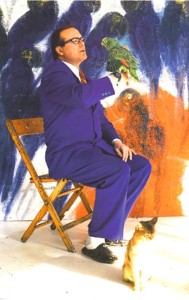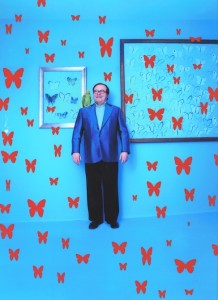
Published: April 26, 2015 — The Times – Tribune
An American artist known for colorful pictures of birds and rabbits and a compulsion for collecting is leasing the Watres Armory in Scranton and pledges to preserve the building.
What Hunt Slonem, the Manhattan-based artist, will do with the building is up in the air. However, his interest in the building and the Electric City has created a buzz in arts and urban development circles, where most believe the attention will benefit the city.
“I don’t believe people choose buildings, I believe buildings choose people,” Mr. Slonem, 63, said in an email. “I just fell in love with it.”
Mr. Slonem said he does not plan to take possession of the building from Donald Mammano Jr. until the fall and while it is a lease, he says he has a “lifetime commitment” to the building. Mr. Slonem is not sure what he will do with it.
“Once I saw it, I just needed to be part of it!” he wrote. “I have lots of fun and exciting ideas for the building … let’s just see what happens.”
Mr. Mammano, through DFM Properties, purchased the Watres Armory, also known as the Scranton National Guard Armory, from the state for $150,000 to save the building from the wrecking ball. Finding a new use for the vacant building was a challenge. He gauged interest from the medical school and hospitals and considered using it to store vehicles.
Mr. Mammano has had crews working in the 102,000-square-foot building that includes administrative offices, a dining hall and kitchen. The building is on the National Register of Historic Places having served not only as an armory, but a whistle stop for campaign presidents, a clinic curing epidemics, athletic courts for the University of Scranton and a performance hall that drew performers, including Russian composer and pianist Sergei Rachmaninoff.
“I’m not at liberty to discuss the plans, since things are still in the works,” Mr. Mammano said.
Although he had nothing to do with the deal, John Cognetti of Hinerfeld Commercial Real Estate is intrigued by the creative use of the building.
He said the open space and ample natural lighting lends itself to showing large format works and installations, if Mr. Slonem decides to ever use it for such a purpose.
“I’m glad an historic property can be saved by a creative use,” he said. “The building can be an asset anchoring the lower Hill section.”
A native of Maine, Mr. Slonem grew up in a military family and lived at times in Hawaii, Nicaragua and Louisiana. He studied art at Tulane University and Skowhegan School of Painting and Sculpture. One of his first art jobs was teaching painting to senior citizens in New York City in the early 1970s. He has been based there ever since.
Categorized as a neo-expressionist, Mr. Slonem’s work is part of the collections at leading museums, such as Whitney Museum of American Art, which has an untitled piece that features oversized pigeons on the crown of the Statue of Liberty. His work is also held by the Smithsonian, the Metropolitan Museum of Art, and the Guggenheim Museum. Like many of his contemporaries in the 1970s, he extended his art to include patterns. He is best known for his repetitive use of images of birds, butterflies and rabbits. Mr. Slonem compares them to meditations or the visual equivalent of a mantra.
He has a personal aviary in lower Manhattan and often paints with an exotic bird perched on his shoulder. Comforted by clutter, his homes, studios and other building are crammed with antique furniture and objects collected from world travels and trips to flea markets and antique stores. His striking habitats are favorites for fashion magazine shoots. His work found an audience among starlets such as Jennifer Lopez, Kate Hudson and Julianne Moore. A documentary about Mr. Slonem by Maysles Films, a production house founded by the brothers behind acclaimed documentaries “Gimme Shelter” and “Grey Gardens,” is in production.
His work is popular with art buyers — his prodigious output sells for five- and six-figures.
While Robert Stecker, Ph.D., editor of the Journal of Aesthetics and Art Criticism, never heard of Mr. Slonem, he did review some of his work.
He pointed out the flashy colors, and pleasing-to-the-eye subjects, beautiful patterns out of step with the majority of contemporary art.
“There’s no uniform characterization of contemporary art, but it is generally political and dark and would rather upset you than please you,” Dr. Stecker said.
Linda Dugan Partridge, Ph.D., professor of art history at Marywood University, has seen Mr. Slonem’s work in gallery exhibits in magazines such as Architectural Digest. The paintings say more than a quick glance would suggest.
In art, birds are almost always proxies for people, she said. Rabbits, which Mr. Slonem said he began painting when he learned it was his Chinese zodiac sign, have rich symbolic meaning in Asian cultures, she said.
“On the surface, we see this simplistic subject matter that is formally beautiful with dense and rich paint application — but the imagery is significant,” she said.
She defended Mr. Slonem’s effective entrepreneurism and self promotion. Mr. Slonem has reached into the world of home design and accessories — scarves, carpets, handbags.
“Turning art into the decoration used to be anathema, but not any more,” she said. “This idea of the hermitic artist in some ivory tower is old.”
Scranton impact
The impact he may have on the local art community or Scranton’s profile is hard to foresee absent clear plans or an indication of how much Mr. Slonem will even be in Northeast Pennsylvania. He would already be dividing his time between two estates in Louisiana, a home in the Hudson Valley, and his base in New York City. Local artist Earl Lehman serves on the board of Scranton’s artist-run AFA Gallery. Working in his studio — a spare room in his Jessup home — he joked that his income may be enough to cover the maintenance of Mr. Slonem’s aviary. He would be surprised if Mr. Slonem took more than a passing interest in Scranton. Artists at his level of success have incredible demands on their time and are expected to be in New York City, the hub of the arts universe.
“Having someone of his reputation take an interest in our area and save that building is fantastic,” he said. “But I can’t imagine he’d become all that involved.”
Joshua Mast, who four years ago left a career in publishing and design in New York City to restore the Colonnade and operate Posh restaurant in Scranton, was not familiar with Mr. Slonem’s work, but welcomed the news. The impact of having an artist’s outpost in town will depend on how Mr. Slonem and the community approach each other, he said.
“If his approach is ‘how can I help?’ or ‘I’d like to be part of this’ it will go far and make a greater difference than if he comes in as a successful New York City artist looking down at our local arts infrastructure,” Mr. Mast said. “Also, groups here need to be ready to say ‘here’s what we do, here’s our specialties, if they fit in with your plans we are willing to help.’”
Mr. Mast lamented the demise of ArtsSpace project, which would have created a live-work community for artists at the former Scranton Lace Building. He wondered if the armory, in the hands of an artist, could have a similar use. There’s still opportunity to pitch Scranton as low-cost refuge for hungry artists, leveraging its proximity to New York and Philadelphia, and urbanesque feel, and a vibrant community of local artists, he said.
Teri Ooms, executive director of the Institute for Public Policy & Economic Development, a think tank backed by local colleges, has long talked about the inevitability and benefit of in-migration.
“Although this is an investment purchase and not in-migration, the fact that he is a prominent member of the arts community has the potential to send a signal to others that Scranton is a hospitable place for them,” she said.
Contact the writer: dfalchek@timesshamrock.com
Hunt Slonem
Birthplace: Kittery, Maine
Age: 63
Education: Tulane University, Skowhegan School of Painting and Sculpture, Vanderbilt University.
Hobbies: Collecting furniture, curiosities and live tropical birds
Favorite subjects: Birds, rabbits, butterflies, saints, Abraham Lincoln
Museums with Slonem’s work: More than 50 worldwide, including Smithsonian American Art Museum, National Gallery of Art, Boston Museum of Fine Arts, Whitney Museum of American Art and the Guggenheim Museum.
Best known piece: “St. Martin de Porres,” 1983, in the collection of the Metropolitan Museum of Art
Books by Hunt Slonem: When Art Meets Design, 2014; Bunnies, 2014; Hunt Slonem: Saints and Angles, 2008; Hunt Slonem: Exotica, 1998.
Famous Relative: Author Tama Janowitz is a cousin. Mr. Slonem’s work has been featured on her book covers.
Quote: “I was influenced by Warhol’s repetition of soup cans and Marilyn. But I’m more interested in doing it in the sense of prayer, with repetition… It’s really a form of worship.”





